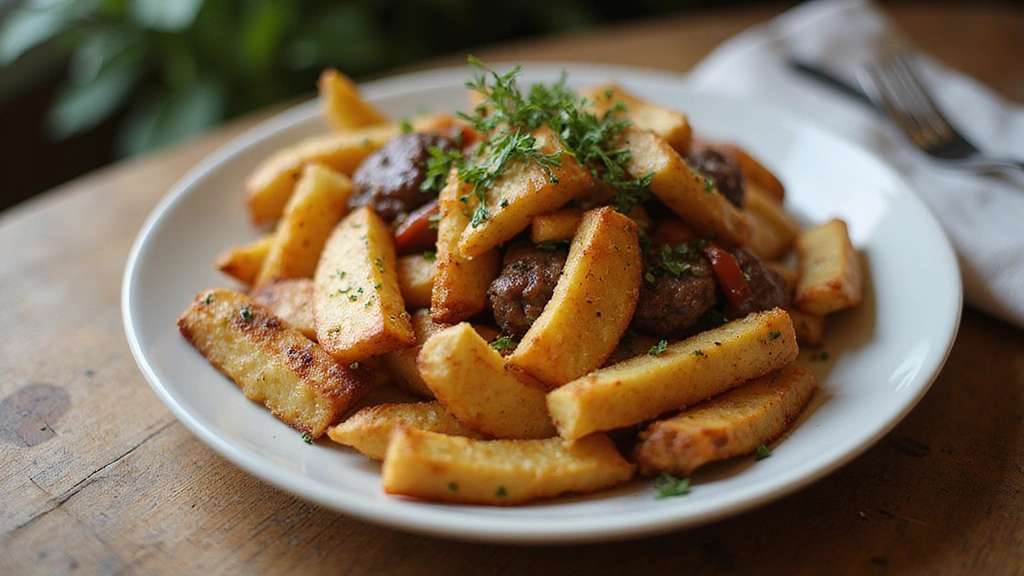Steak fries are the epitome of comfort food, providing a satisfying crunch and a fluffy interior that makes them irresistible.
Their thick, golden appearance is not just a treat for the eyes, but each bite delivers a hearty potato flavor that pairs perfectly with your favorite dipping sauces.
I first fell in love with steak fries during a summer barbecue, where they stole the show as the perfect side to grilled meats.
Whether you’re serving them alongside a juicy steak or enjoying them as a standalone snack, these steak fries are sure to impress everyone at your table.
The History and Cultural Significance
• Steak fries trace their origins to Belgium, where they are thought to have been created in the late 19th century as a heartier alternative to traditional fries.
• The dish evolved over decades, influenced by American dining culture, and became a staple in pubs and casual dining restaurants.
• In American culture, steak fries traditionally appear at barbecues and family gatherings, symbolizing comfort and togetherness.
• While many variations exist across different regions, the authentic version maintains a thick cut that gives them their signature crunchy exterior and fluffy interior.
Recipe Overview
Nutritional Information (per serving)
Ingredients
Essential Equipment Guide
Chef’s Knife: A sharp chef’s knife is crucial for cutting the potatoes into uniform wedges, ensuring even cooking. Look for one with a comfortable grip and a blade length of 8-10 inches for versatility.
Cutting Board: A sturdy cutting board provides a safe surface for cutting. Choose one made of wood or plastic that won’t dull your knife and is easy to clean.
Large Baking Sheet: A heavy-duty baking sheet helps achieve maximum crispiness for the fries. Look for a rimmed sheet to prevent any oil spillage during cooking.
Preparation Methods
Cutting the Potatoes: To achieve perfectly shaped steak fries, cut the potatoes into thick wedges. This technique allows for a crispy exterior while keeping the inside fluffy. Use a sharp chef’s knife for clean cuts and ensure uniform sizes for even cooking.
Tossing in Oil and Seasonings: Tossing the potatoes in olive oil and seasonings before baking ensures they are evenly coated and enhances flavor. Make sure each wedge is coated to promote even browning and crispiness during baking.
Baking at High Heat: Baking the fries at a high temperature (425°F) is essential for achieving that crispy exterior. Make sure to spread them out in a single layer on the baking sheet to allow hot air to circulate around each piece.
Step 1: Prepare Ingredients

Begin by washing and peeling the Russet potatoes.
Cut them into thick wedges, about 1 inch wide.
Aim for uniformity in size to ensure even cooking.
Place the cut potatoes in a bowl and set aside.
Step 2: Preheat the Oven
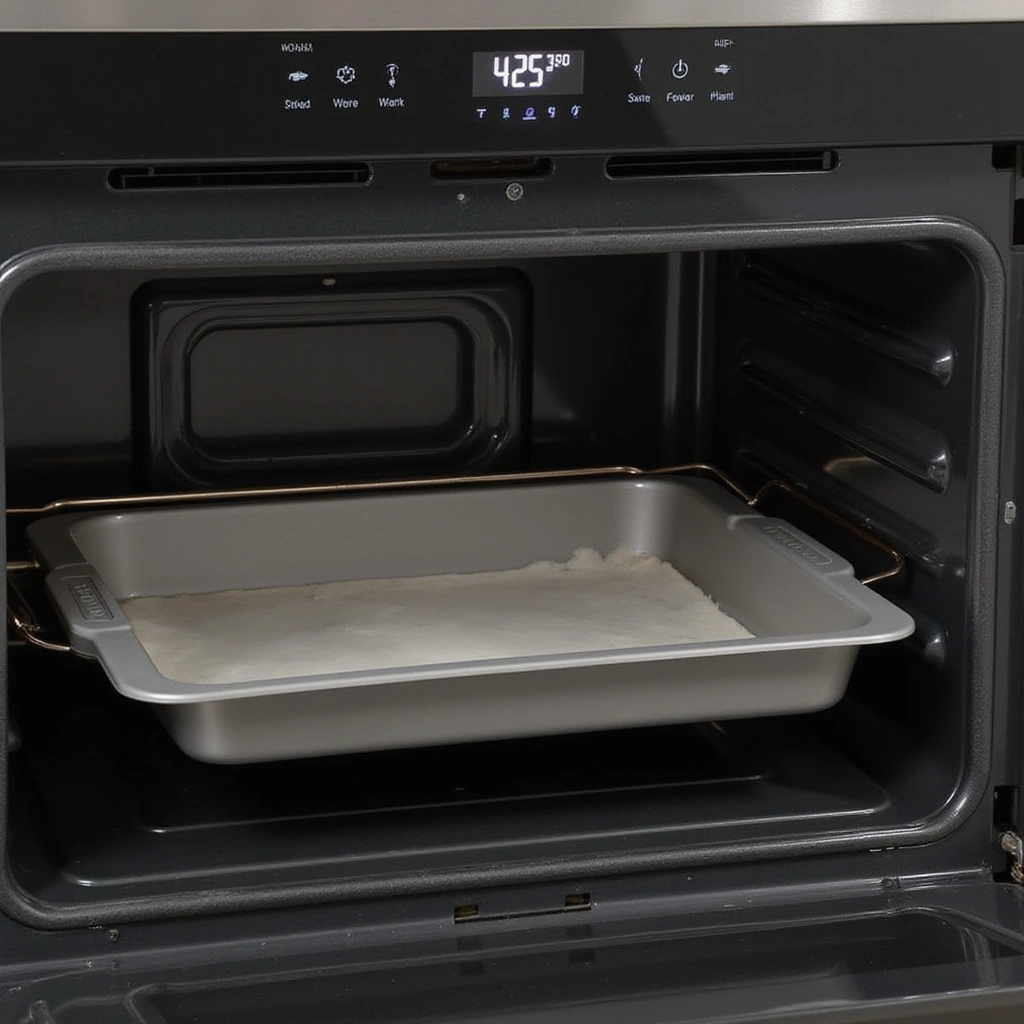
Preheat your oven to 425°F (220°C).
This high temperature is crucial for achieving crispy fries.
Make sure your oven is fully preheated before placing the fries inside.
An oven thermometer can help ensure accuracy.
Step 3: Toss Potatoes in Oil

In a large bowl, add the thick potato wedges.
Drizzle with olive oil and sprinkle the salt, pepper, garlic powder, and paprika.
Use your hands or a spatula to toss everything together until the fries are evenly coated.
This step is vital for ensuring flavor and texture.
Step 4: Arrange on Baking Sheet
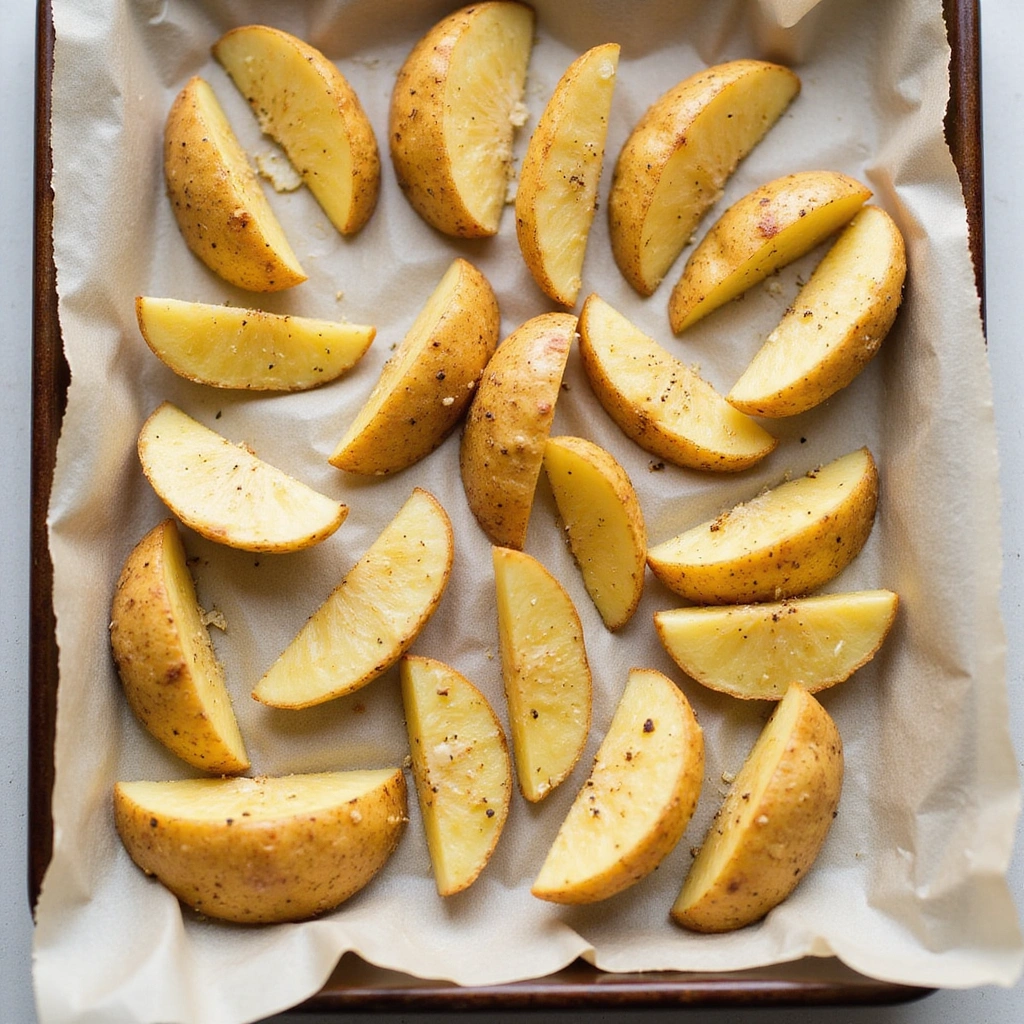
Take a large baking sheet and line it with parchment paper for easy cleanup.
Spread the seasoned potato wedges in a single layer on the sheet.
Make sure they are not overlapping to allow for proper air circulation.
This arrangement ensures even cooking and crispiness.
Step 5: Bake the Fries
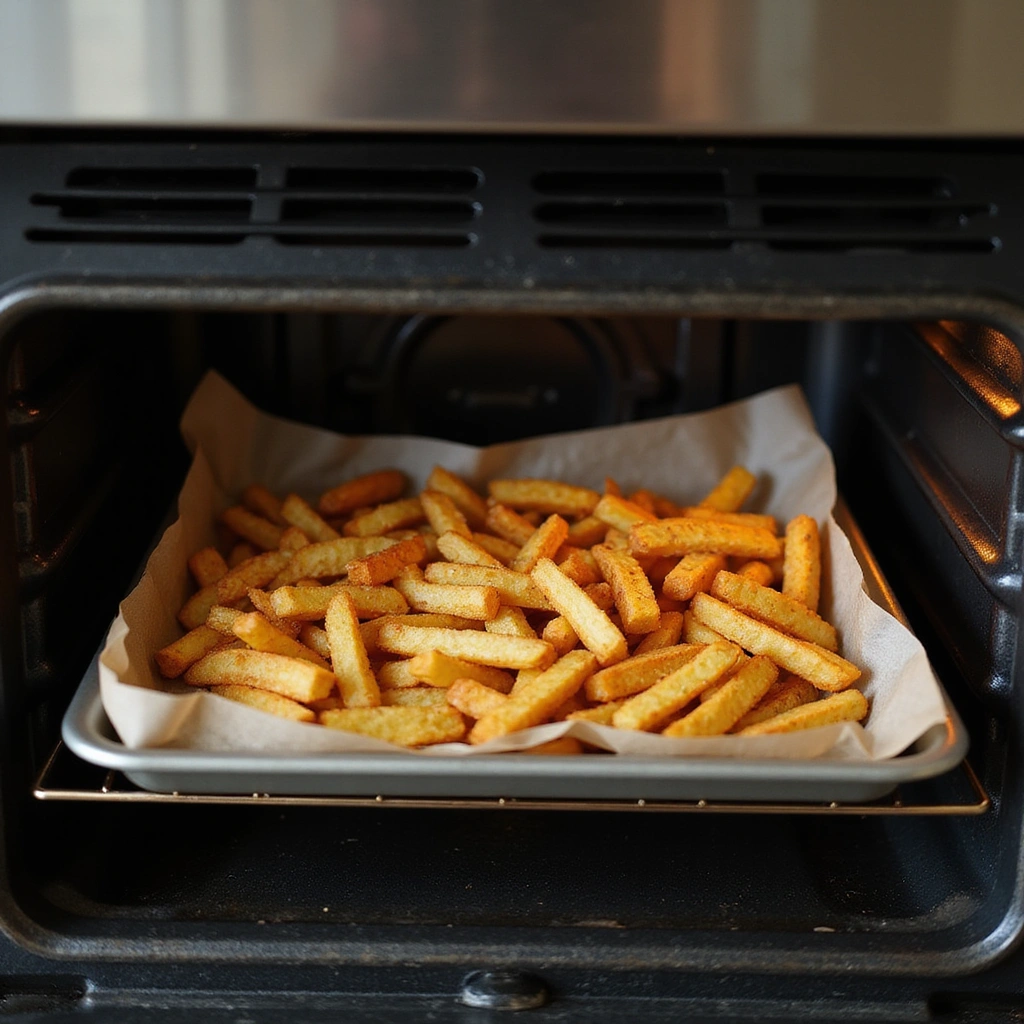
Place the baking sheet in the preheated oven.
Bake for about 30 minutes, flipping the fries halfway through for even browning.
Look for a golden-brown color and a crispy texture as indicators of doneness.
Keep an eye on them to prevent burning.
Step 6: Check for Doneness
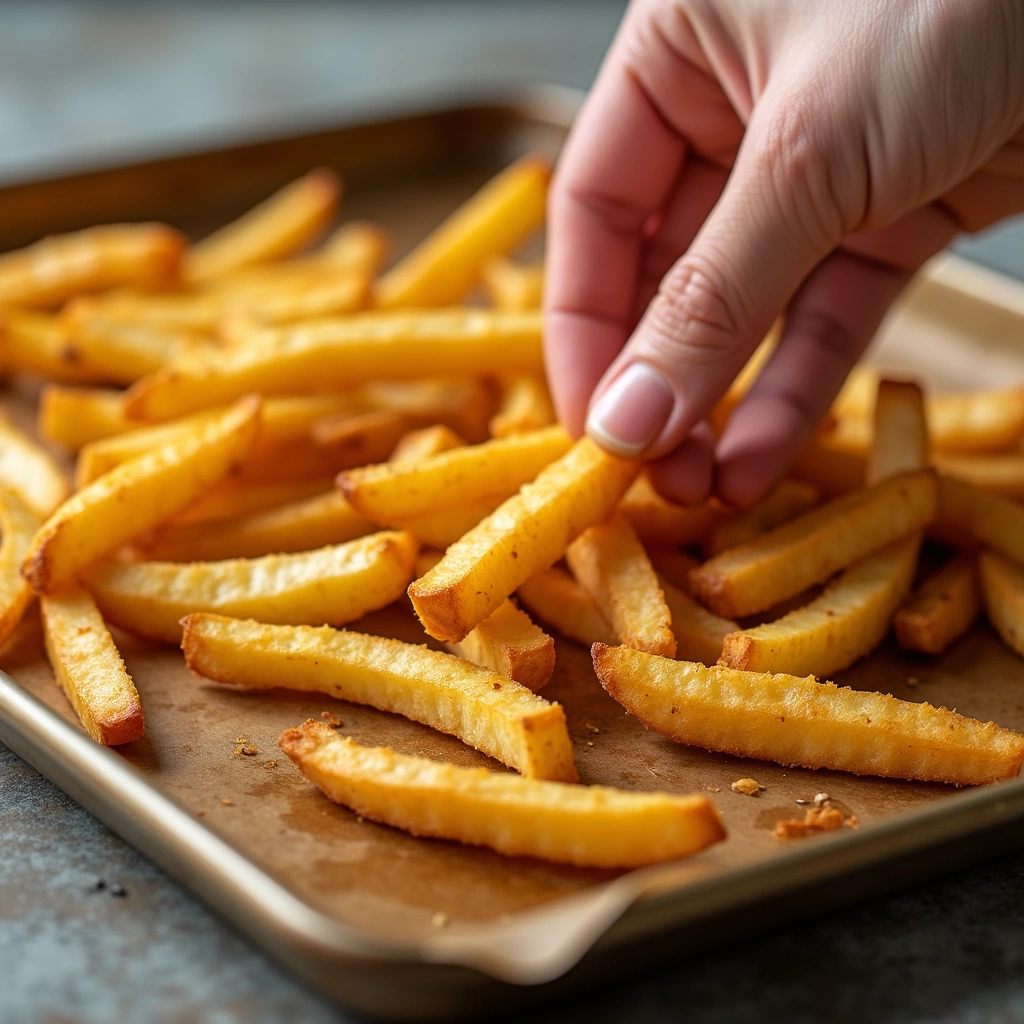
After 30 minutes, check the fries for crispiness and color.
They should be golden brown and crispy on the outside.
If they need more time, continue baking for an additional 5-10 minutes.
Avoid opening the oven too often to maintain the temperature.
Step 7: Serve Hot
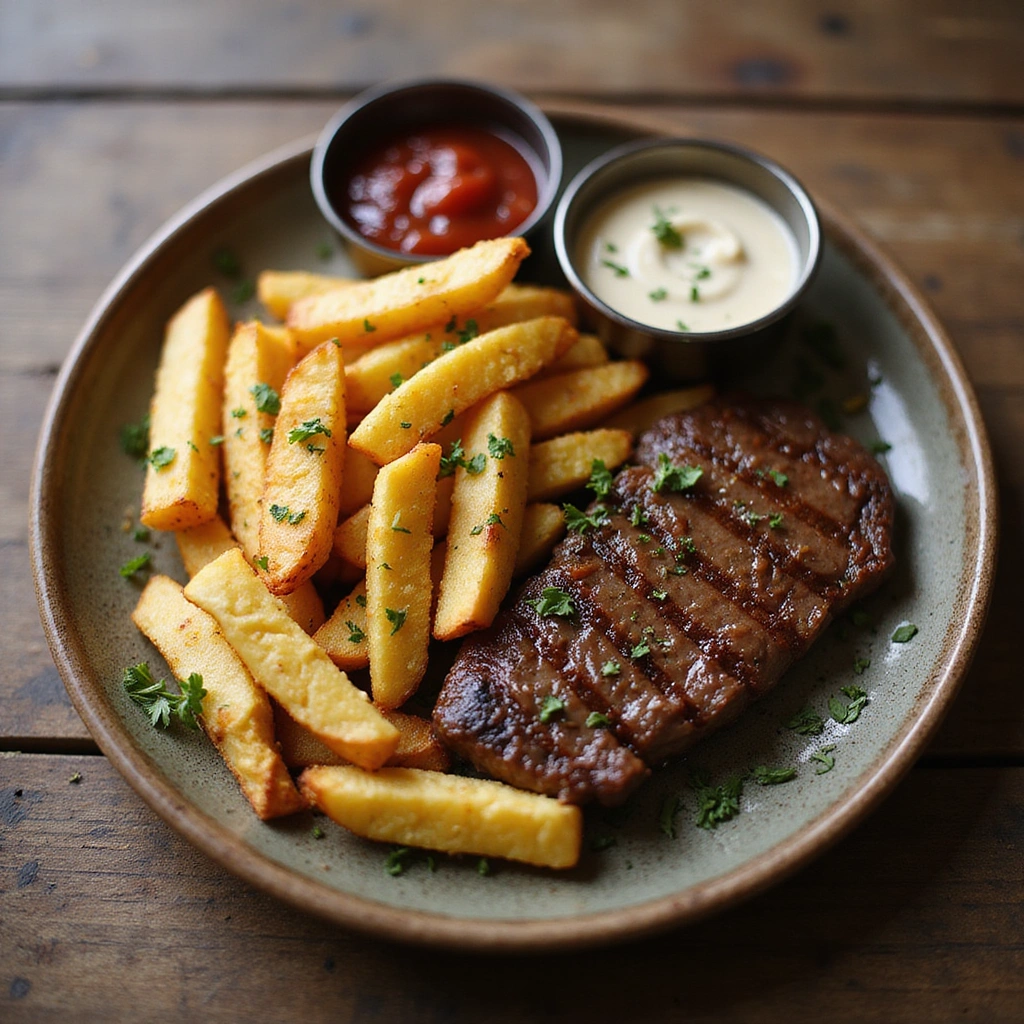
Once done, remove the fries from the oven and let them cool for a few minutes.
Serve hot with your favorite dipping sauces like ketchup or aioli.
Garnish with fresh herbs if desired for an extra touch.
Enjoy the perfect balance of crispy and fluffy textures.
Step 8: Enjoy Your Meal

Gather everyone around the table to enjoy the freshly made steak fries.
Pair them with your favorite main dish or enjoy them alone.
The aroma and taste will surely delight your guests.
Don’t forget to share your cooking experience!
Critical Timing and Temperature Guide
Oven Preheating: Always preheat the oven to 425°F for at least 10-15 minutes before baking. This ensures that the fries start cooking immediately, leading to a crispy texture.
Baking Time: Bake for 30 minutes, turning halfway through. If they aren’t golden brown, add 5-10 minutes but watch closely to avoid burning.
Cooling Time: Allow the fries to cool for a few minutes after baking. This brief resting period helps them firm up and enhances the crunch.
Pro Tips for Steak Fries
• Ingredient Selection: Choose fresh, firm Russet potatoes for the best texture and flavor. Their high starch content makes them ideal for frying.
• Preparation Secret: Soaking the cut potatoes in water for 30 minutes before baking helps remove excess starch, leading to a crispier fry.
• Temperature Management: Ensure your olive oil is at room temperature before tossing it with the potatoes, which helps the seasonings to stick better.
• Texture Enhancement: For extra crunch, consider adding a sprinkle of cornstarch to the seasoned fries before baking.
• Flavor Layering: Experiment with different seasonings like rosemary or Parmesan cheese for added depth of flavor.
• Make-Ahead Strategies: You can cut and soak the potatoes the night before; just make sure to dry them thoroughly before tossing with oil and seasonings.
• Restaurant-Quality Finishing Touches: Serve fries with a sprinkle of sea salt and fresh herbs right before serving for an elevated touch.
• Equipment Optimization: Use a convection oven if available, as it circulates air better and results in crispier fries.
Troubleshooting Common Issues
• Fries Too Soggy: This can happen if the potatoes are not dried properly after soaking. Ensure they are well-dried to allow the oil to create a crispy exterior.
• Uneven Cooking: If some fries are crispy while others are soft, it may be due to overcrowding on the baking sheet. Always arrange in a single layer to allow for proper air flow.
• Burnt Fries: If your fries are burning, check your oven temperature accuracy. Use an oven thermometer to ensure it’s set correctly.
• Flavor Lacking: If the fries taste bland, increase the amount of seasonings used. A well-seasoned fry is crucial for flavor.
• Texture Too Dense: Thick-cut fries may take longer to cook. Consider cutting them thinner for a crispier result or adjusting the cooking time.
Variations and Regional Differences
• Belgian Frites: In Belgium, fries are often served with a variety of dipping sauces, including mayonnaise, and are cut thinner. This variation emphasizes the sauce over the fry itself.
• Loaded Steak Fries: A popular American variation, loaded fries are topped with cheese, bacon, and sour cream, creating a hearty dish perfect for sharing.
• Sweet Potato Fries: A healthier alternative, these are made with sweet potatoes and often seasoned with cinnamon or cayenne for added flavor.
• Modern Interpretations: Chefs today experiment with different oils and seasonings, like truffle oil or herbs de Provence, to give the classic steak fry a gourmet twist.
Food Science Behind the Recipe
• Maillard Reaction: This chemical reaction occurs when the fries are exposed to high heat, creating that golden-brown crust and enhancing flavor. Understanding this helps in achieving the perfect fry.
• Starch Gelatinization: When potatoes are heated, starches gelatinize, which is crucial for achieving a fluffy interior. This process is what gives steak fries their comforting texture.
• Oil Temperature: Using the right amount of oil at the right temperature is essential for crispiness. Too little oil can lead to soggy fries, while too much can cause them to become greasy.
Frequently Asked Questions
What’s the most common mistake people make when preparing steak fries? The biggest mistake is not drying the potatoes properly after soaking, which leads to sogginess. Be sure to pat them dry before adding oil.
Can I prepare components of this dish in advance? Yes, you can cut and soak the potatoes a day before. Just make sure to dry them thoroughly before cooking.
How do I adapt this recipe for dietary restrictions? For a gluten-free option, ensure all seasonings are gluten-free and consider using an air fryer for cooking.
What’s the best way to store and reheat leftovers? Store in an airtight container in the fridge for up to 3 days. Reheat in the oven at 350°F for about 10 minutes to restore crispiness.
Can I freeze this dish? Yes, you can freeze raw, cut potatoes for up to 3 months. Cook from frozen, but increase the cooking time by about 5-10 minutes.
What wine or beverages pair best with this dish? A light lager or a crisp white wine like Sauvignon Blanc complements the fries beautifully.
How can I scale this recipe up for a crowd? Simply multiply the ingredients, but be sure to bake in batches to avoid overcrowding the baking sheet.
What side dishes complement this recipe best? Steak fries pair well with burgers, grilled meats, or a fresh salad for balance.
How do professional chefs elevate this dish for restaurant service? Many chefs add unique toppings or serve with gourmet sauces, enhancing the flavor profile and presentation.
Serving and Presentation Guide
• Traditional Presentation: Serve the steak fries in a rustic bowl or on a wooden board, garnished with fresh herbs and accompanied by small bowls of dipping sauces.
• Modern Plating Ideas: Consider stacking the fries slightly for a height effect, drizzling with truffle oil, and sprinkling with Parmesan cheese for a gourmet touch.
• Accompaniment Suggestions: Pair with aioli, sriracha mayo, or a tangy dipping sauce to enhance flavor.
• Special Occasion Presentation: Serve in individual mini fry baskets for a fun twist at parties or gatherings.
Conclusion
Making classic steak fries is a rewarding experience that brings comfort to any meal.
With their perfect blend of crispy and fluffy textures, they are bound to be a hit.
I encourage you to try this recipe and savor the delicious flavors at your next gathering.
